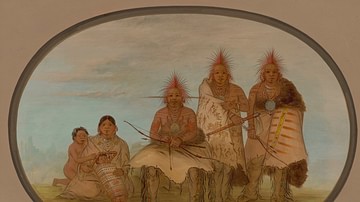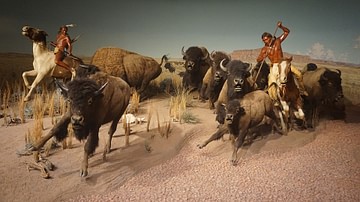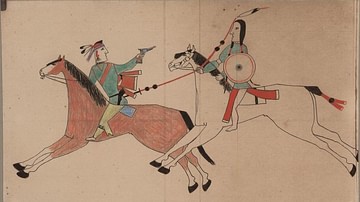The Boy Who Saw A-ti'us is a legend of the Pawnee nation about a young man who is granted a vision of the Creator Ti-ra'wa A-ti'us (also known simply as Ti-ra'wa or as A-ti'us) and, through his faith, is able to see what others cannot and so saves his people from starvation.

The story works with the theme, common not only to Pawnee legends but those of many Native peoples of North America, of the poor young man who is rewarded by the Creator for his kindness and generosity toward others. Although boasting of one's accomplishments was not only accepted but also expected, from young men, humility was highly valued, and many tales from various nations warn against the dangers of thinking too highly of oneself. In this same way, stories from all Native nations – including those of the Plains Indians, encourage the values of modesty, kindness, generosity, and gratitude.
This story is an example of the latter, in which a poor orphan boy is taken in by a widow and returns her kindness by caring for her and her two children as if he were a member of the family. This is in keeping with Pawnee values and behavior, but it is noted in the text that the boy always brings any food he finds to the woman – not saving any out for himself – to be divided among the four of them. His selflessness is then rewarded by Ti-ra'wa A-ti'us with the vision that will change the boy's life and restore his people.
The story not only serves to encourage cultural values and faith in an audience but also as an origin tale in that it explains how and why the position of chief in Pawnee leadership, once held by women – since the first created human was understood as female – passed to men. Mainly, however, the focus of the tale is fixed on the importance of individual integrity and faith in the knowledge that, no matter how bleak a situation, the Creator is always present and prepared to offer help.
Ti-ra'wa A-ti'us
Ti-ra'wa A-ti'us ("Our Father Above") is the Creator God of the Pawnee who gave them life and the gifts essential for their survival including agriculture, the concept of clothing and ornamentation, fire, hunting skills and the animals to hunt, the power of speech and imagination, and the proper observance of sacred ritual and sacrifice. His wife is Atira ("Mother Corn"), an earth goddess (associated with Mother Earth), and all the other gods are observable as stars in the night sky, but behind all – and invisible – is Ti-ra'wa A-ti'us.
Ti-ra'wa created the expanse in the sky now known as the Milky Way but known to the Pawnee, and others, as the Path or the Path of Departing Spirits, which led one's soul home after death. Once arrived in the afterlife, the soul would live fully in the presence of the Creator, but he still remained invisible. The vision given in The Boy Who Saw A-ti'us would have therefore been exceptional to the original audience in that the god's presence could certainly be felt at any time, but he could never be actually seen, just like the wind.
Text
The following is taken from Pawnee Hero Stories and Folk-Tales (1889) by George Bird Grinnell. Parfleche in the story is rawhide and the swans are significant not only as birds – often depicted in Pawnee tales as messengers and servants of Ti-ra'wa A-ti'us – but also because they symbolize purity, strength, wisdom, hope, and transformation and are also associated with the north, the direction of the Creator's home, and so with his power.
Many years ago, the Pawnees started on their winter hunt. The buffalo were scarce, and the people could get hardly any meat. It was very cold, and the snow lay deep on the ground. The tribe traveled southward, and crossed the Republican, but still found no buffalo. They had eaten all the dried meat, and all the corn that they had brought with them, and now they were starving. The sufferings of the people were great, and the little ones began to die of hunger. Now they began to eat their robes, and parfleches, and moccasins.
There was in the tribe a boy about sixteen years old, who was all alone, and was very poor. He had no relations who could take care of him, and he lived with a woman whose husband had been killed by the Sioux. She had two children, a boy and a girl; and she had a good heart and was sorry for the poor boy. In this time of famine, these people had scarcely anything to eat, and whenever the boy got hold of any food, he gave it to the woman, who divided it among them all.
The tribe kept traveling southward looking for buffalo, but they had to go very slowly, because they were all so weak. Still, they found no buffalo, and each day the young men that were sent out to look for them climbed the highest hills, and came back at night, and reported that they could only see the white prairie covered with snow. All this time little ones were dying of hunger, and the men and women were growing weaker every day.
The poor boy suffered with the rest, and at last he became so weak that he hardly could keep up with the camp, even though it moved very slowly. One morning he was hardly able to help the old woman pack the lodge, and after it had been packed, he went back to the fire, and sat down beside it, and watched the camp move slowly off across the valley, and up over the bluffs. He thought to himself, "Why should I go on? I can't keep up for more than a day or two longer anyhow. I may as well stay here and die." So he gathered together the ends of the sticks that lay by the fire, and put them on the coals, and spread his hands over the blaze, and rubbed them together, and got warm, and then lay down by the fire, and pretty soon he went to sleep.
When he came to himself, it was about the middle of the day, and as he looked toward the sky, he saw two spots there between him and the sun, and he wondered what they were. As he looked at them, they became larger and larger, and at last he could see that they were birds; and by and by, as they came still nearer, he saw that they were two swans. The swans kept coming lower and lower, and at last they alighted on the ground right by the fire and walked up to where the boy lay. He was so weak he could not get up, and they came to him, one on each side, and stooped down, and pushed their shoulders under him, and raised him up and put him on their backs, and then spread their broad wings, and flew away upward. Then the boy went to sleep again.
When he awoke, he was lying on the ground before a very big lodge. It was large and high, and on it were painted pictures of many strange animals, in beautiful colors. The boy had never seen such a fine lodge. The air was warm here, and he felt stronger than before. He tried to raise himself up, and after trying once or twice he got on his feet, and walked to the door of the lodge, and went in. Opposite the door sat A-ti'-us. He was very large and very handsome, and his face was kind and gentle. He was dressed in beautiful clothes and wore a white buffalo robe. Behind him, from the lodge poles, hung many strange weapons. Around the lodge on each side sat many chiefs, and doctors, and warriors. They all wore fine clothes of white buckskin, embroidered with beautifully colored quills. Their robes were all of beaver skin, very beautiful.
When the boy entered the lodge, A-ti'-us said to him, "Looah, pi-rau', we-tŭs sūks-pit—Welcome, my son, and sit down." And he said to one of the warriors, "Give him something to eat." The warrior took down a beautifully painted sack of parfleche, and took his knife from its sheath, and cut off a piece of dried meat about as big as one's two fingers, and a piece of fat about the same size, and gave them to the boy. The boy, who was so hungry, thought that this was not very much to give to one who was starving, but took it, and began to eat. He put the fat on the lean, and cut the pieces off, and ate for a long time. But after he had eaten for a long time, the pieces of meat remained the same size; and he ate all that he wanted, and then put the pieces down, still the same size.
After the boy had finished eating, A-ti'-us spoke to him. He told him that he had seen the sufferings of his people and had been sorry for them; and then he told the boy what to do. So, he kept the boy there for a little while longer, and gave him some fine new clothing and weapons, and then he told one of the warriors to send the boy back; and the warrior led him out of the lodge to where the swans were standing near the entrance, and the boy got on to their backs. Then the warrior put his hand on his face, and pressed his eyelids together, and the boy went to sleep. And by and by the boy awoke and found himself alone by the fire. The fire had gone out, but the ground was still covered with snow, and it was very cold.
Now the boy felt strong, and he stood up, and started, running along the trail which the camp had taken. That night after dark he overtook the camp, for they traveled very slowly, and he walked through the village till he came to the lodge where the woman was, and went in. She was surprised to see him in his new clothes, and looking so well and strong, and told him to sit down. There was a little fire in the lodge, and the boy could see that the woman was cutting up something into small pieces with her knife.
The boy said to her, "What are you doing?"
She answered, "I am going to boil our last piece of robe. After we have eaten this there will be nothing left, and we can then only die."
The boy said nothing, but watched her for a little while, and then stood up and went out of the lodge. The door had hardly fallen behind him, when the woman heard a buffalo coughing, and then the breaking of the crisp snow, as if a heavy weight was settling on it. In a moment the boy lifted the lodge door, and came in, and sat down by the fire, and said to the woman, "Go out and bring in some meat." The woman looked at him, for she was astonished, but he said nothing, so she went out, and there in the snow by the side of the lodge was a fat buffalo cow. Then the woman's heart was glad. She skinned the cow and brought some of the meat into the lodge and cooked it, and they all ate and were satisfied. The woman was good, so she sent her son to the lodges of all her relations, and all her friends, and told them all to come next morning to her lodge to a feast, "for," she said, "I have plenty of meat."
So, the next morning all her relations and all her friends came, so many that they could not all get into the lodge, but some had to stand outside, and they ate with her, and she cooked the meat of the cow for them, and they ate until it was all gone, and they were satisfied. And after they had done eating, they lighted their pipes and prayed, saying, "A-ti'-us, we'-tŭs kit-tah-we—Father, you are the ruler."
While they were smoking, the poor boy called the woman's son to him, and pointed to a high hill near the camp, and said, "Looah, sūks-kus-sis-pah ti-rah hah-tūr—Run hard to the top of that hill and tell me what you see." So, the boy threw off his robe, and smoothed back his hair, and started, and ran as hard as he could over the snow to the top of the hill. When he got there, he shaded his eyes with his hand, for the sun shone bright on the snow and blinded him, and he looked east, and west, and north, and south, but he could see nothing but the shining white snow on the prairie.
After he had looked all ways, he ran back as hard as he could to the village. When he came to the lodge, he went to the poor boy, and said to him, "I don't see anything but the snow." The poor boy said, "You don't look good. Go again." So, the boy started again, and ran as hard as he could to the hilltop, and when he got there, panting, he looked all ways, long and carefully, but still, he could see nothing but the snow. So, he turned and ran back to the village, and told the poor boy again that he saw nothing. The boy said, "You don't look good." Then he took his bow in his hand, and put his quiver on his back, and drew his robe up under his arm so that he could run well, and started, himself, and ran as hard as he could to the top of the hill, and when he got there he looked off to the south, and there, as far as he could see, the plain was black with buffalo struggling in the deep snow.
And he turned to the village and signaled them with his robe that buffalo were in sight. In a few minutes all the Pawnees had seized their bows and arrows, and were running toward him, and the women fixed the travois, and took their knives, and followed. The boy waited on the hilltop until the warriors came up, and then they went down to the buffalo, running on the snow. The buffalo could not get away on account of the deep snow, and the Pawnees made a great killing. Plenty of fat meat they got, enough to last them until the summer hunt, and plenty of warm winter robes. They did not have to move any further, but stayed right here, killing meat, and drying it until they were all fat and strong again.
And the poor boy became a great doctor in the tribe and got rich.
Before this, the Pawnee had always had a woman chief, but when the woman who was chief died, she named the poor boy as her successor, and the people made him head chief of the tribe.





